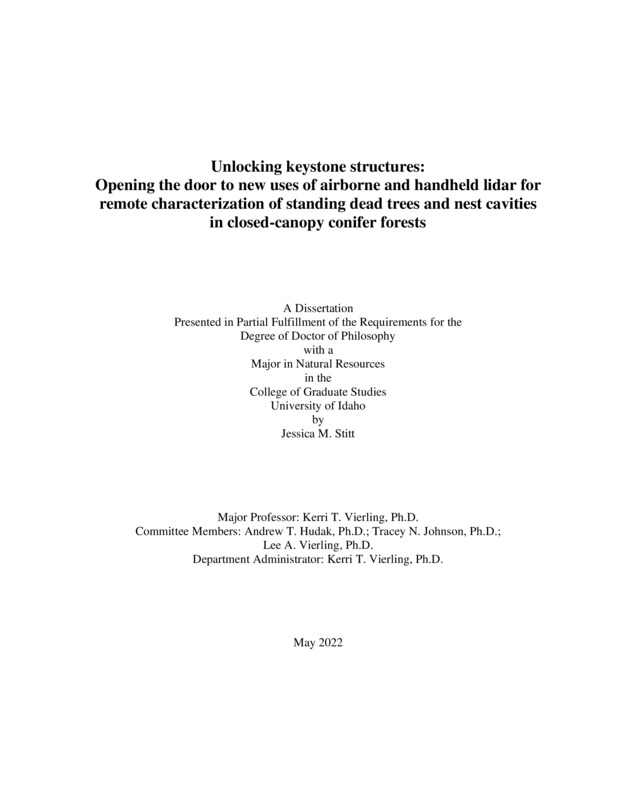Unlocking keystone structures: Opening the door to new uses of airborne and handheld lidar for remote characterization of standing dead trees and nest cavities in closed-canopy conifer forests
Stitt, Jessica M.. (2022-05). Unlocking keystone structures: Opening the door to new uses of airborne and handheld lidar for remote characterization of standing dead trees and nest cavities in closed-canopy conifer forests. Theses and Dissertations Collection, University of Idaho Library Digital Collections. https://www.lib.uidaho.edu/digital/etd/items/stitt_idaho_0089e_12331.html
- Title:
- Unlocking keystone structures: Opening the door to new uses of airborne and handheld lidar for remote characterization of standing dead trees and nest cavities in closed-canopy conifer forests
- Author:
- Stitt, Jessica M.
- ORCID:
- 0000-0002-1023-1115
- Date:
- 2022-05
- Keywords:
- habitat lidar remote sensing standing dead wood wildlife woodpecker
- Program:
- Natural Resources
- Subject Category:
- Wildlife conservation; Wildlife management; Remote sensing
- Abstract:
-
In closed-canopy conifer forests, standing dead trees (known as snags) serve as keystone structures, supporting disproportionate amounts of biodiversity. Their reduced woody structure, as well as their decaying wood, make snags different enough from live trees to provide unique habitat features for wildlife. One such feature of snags in northwestern conifer forests¬ is that they are the preferred sites for woodpeckers to excavate nest cavities, which are also considered keystone structures in this system. Woodpecker cavities are essential to multiple species of birds and mammals for nesting and roosting–and this habitat feature makes locating snags all the more valuable. Using remote sensing to map where snags occur across the landscape is of great benefit in multiple ecological contexts but is made difficult due the sparse, cryptic, and variable nature of standing deadwood throughout a forest.This dissertation tests novel methodologies to evaluate whether one type of remote sensing, light detection and ranging (known as lidar), applied at different spatial scales is sensitive enough to discern structural characteristics pertaining to: (1) snags versus live trees; (2) variation among snags; and (3) tree cavity entrance dimensions. I evaluated lidar at the landscape scale for (1) and (2) to explore the capabilities of airborne lidar for snag detection and characterization in conifer stands of the Idaho Panhandle National Forest. I evaluated lidar at the individual tree scale for (3) to determine the accuracy of smartphone lidar in measuring cavity entrance dimensions under controlled conditions. I found airborne lidar to be (1) effective at distinguishing between snags and live trees at the individual tree level using the proportion of open space surrounding each, but (2) airborne lidar was not high enough resolution to reliably characterize multiple snag classes. I found that smartphone lidar (3) was very accurate in measuring at least one dimension of cavity entrance size, enabling discernment among species of cavity excavators.
- Description:
- doctoral, Ph.D., Natural Resources -- University of Idaho - College of Graduate Studies, 2022-05
- Major Professor:
- Vierling, Kerri T
- Committee:
- Hudak, Andrew T; Johnson, Tracey N; Vierling, Lee A
- Defense Date:
- 2022-05
- Identifier:
- Stitt_idaho_0089E_12331
- Type:
- Text
- Format Original:
- Format:
- application/pdf
- Rights:
- In Copyright - Educational Use Permitted. For more information, please contact University of Idaho Library Special Collections and Archives Department at libspec@uidaho.edu.
- Standardized Rights:
- http://rightsstatements.org/vocab/InC-EDU/1.0/

